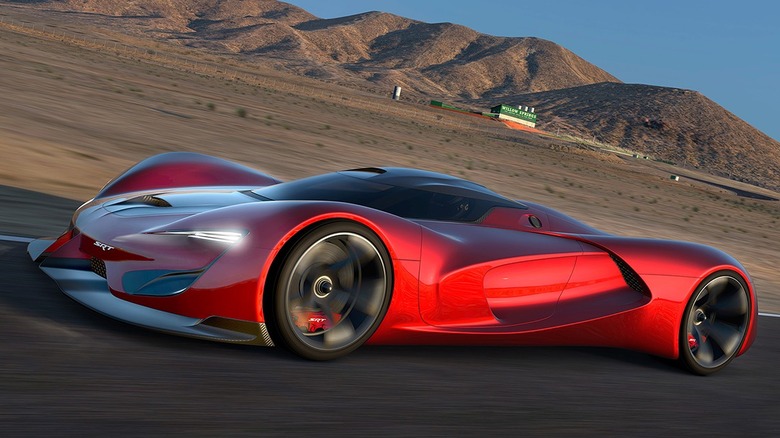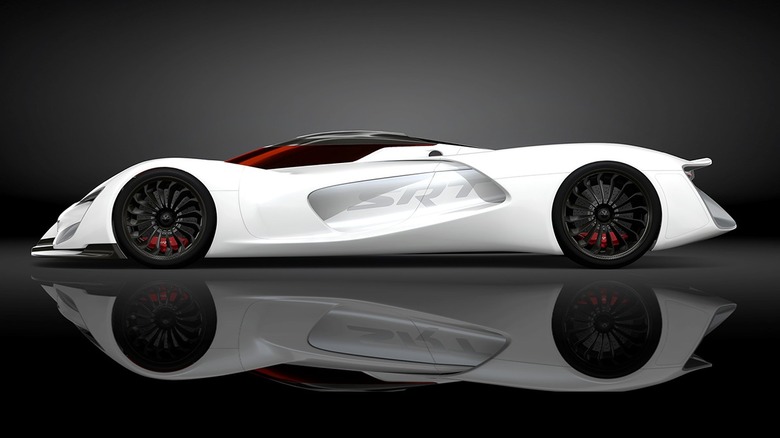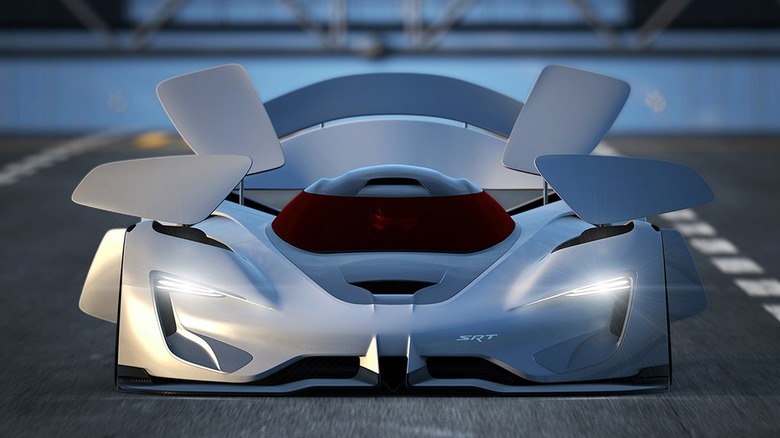Is The Dodge SRT Tomahawk Real? Here's What You Need To Know
Concept cars are a way for an automotive brand to introduce the public to out-of-the-box thinking for automobiles, showcasing a vision for the future through outlandish styling and new technological advancements. Sometimes, the public is lucky enough to see a concept car come to fruition in the form of a production version. Other times they often create a lot of buzz, even if they are never actually produced. In the case of the SRT Tomahawk project, Dodge created a concept car that enthusiasts could drive, just not in the real world.
The story of the Dodge SRT Tomahawk begins with one of the most successful automotive video game franchises in history — "Gran Turismo." In 2013, the video game's developer Polyphony Digital released the sixth mainstream title in the "Gran Turismo" series. As a companion project for the game, Polyphony also launched the "Vision Gran Turismo" program, where the developer encouraged popular automotive manufacturers to submit their vision of the perfect GT car, no matter how extreme. By 2015, 19 of these concept "Vision GT" cars were added to "Gran Turismo 6" from manufacturers ranging from Bugatti to Toyota. Dodge submitted the last Vision GT entry for the game, called the SRT Tomahawk.
While the SRT Tomahawk was designed by members of the same team that was responsible for the road-going Challenger and Charger Hellcat models, they were allowed to design the SRT Tomahawk with almost no concern for practicality, since it was never meant to be a production model. While the SRT Tomahawk isn't a real road-going model, it was given a full hypothetical spec sheet and multiple different trim levels for the game. It's safe to say that if the Dodge SRT Tomahawk did exist, it would put the Viper to shame.
The Dodge SRT Tomahawk's specs are out of this world
With nothing but their imagination limiting the SRT Tomahawk's potential, the team responsible for designing the concept went truly wild with the car's powertrain specs, aerodynamic enhancements, and overall design. With a fictional model year of 2035, the FCA team imagined what would be possible 20 years into the future from when the Tomahawk's design process started, leading to some pretty outlandish — but not entirely unrealistic — ideas.
The SRT Tomahawk was offered in three different trim levels in "Gran Turismo 6," including S, GTS-R, and X models. Each model increasingly stepped up the Tomahawk's intensity, all driven by an Indy car-derived, 144-degree, 14,500 RPM V10 powering the rear wheels, and a "Variable-Fin Quad-Stage Pneumatic Power Unit" powering the fronts. The Tomahawk's V10 hybrid powertrain ranged in power level, depending on the trim, from 1,007 horsepower to a brain-melting 2,590 horsepower.
While the 7.0L V10 engine did most of the heavy lifting, the integrated pneumatic power unit delivered a hefty amount of power to the front wheels, while also operating other auxiliary features including active aero elements and a pressurized driver G-suit. This suit is meant to prevent driver injury from the extreme forces that the SRT Tomahawk could produce.
The SRT Tomahawk's ultra-low drag body was the product of a company-wide design competition, allowing anyone at Fiat Chrysler Automobiles (FCA) to join regardless of skill or experience level. The winning design by rookie designer Paul Hoste wrapped the single-seat cockpit in an organic "pinched-waist" silhouette, using advanced lightweight materials like graphene and carbon nanofibers. The SRT Tomahawk's featherweight body and advanced weight-saving construction brought its overall weight to between 1,459 pounds and 2,026 pounds — with a power-to-weight ratio of 1.56 horsepower per pound.
The Dodge SRT Tomahawk predicted the direction of future production hypercars
While there were certainly some fantastical elements that cemented the SRT Tomahawk as a fictional car, many of the powertrain and aerodynamic elements built into the Tomahawk have become the norm in hypercars nearly 10 years after the concept was introduced to "Gran Turismo 6." In 2013, hypercars with alternative powertrains were just beginning to become a mainstream phenomenon.
It was the year that the McLaren P1, LaFerrari, and Porsche 918 kicked off the trend of implementing hybrid technology into the world's best performance cars, which continues to this day. All three of the "holy-trinity" hypercars made use of powerful internal combustion engines that were aided by hybrid motors to increase overall output — and sometimes, like in the case of the Porsche 918 sports-hybrid, power the front wheels for an all-wheel-drive system.
Despite using a pneumatic system instead of an electric one, the SRT Tomahawk uses that exact same formula, with the hybrid powertrain driving both the front and rear wheels. Since the SRT Tomahawk's reveal, the hybrid powertrain, all-wheel-drive format has become extremely popular in the recent decade. Manufacturers like the Lamborghini and Acura have used the combination in recent supercars the Revuelto and second-generation NSX.
Active aerodynamics is another key feature of the SRT Tomahawk that is now being utilized by a huge number of modern performance car manufacturers nowadays. The Tomahawk features fender-mounted panels that raise and lower depending on driving conditions which help it produce optimal downforce and braking performance, very similar to how the wheel arch flaps work on the F1-inspired Mercedes AMG One. Other features of the SRT Tomahawk's design like a blown diffuser and energy recovery system preceded the trends that we see in the most advanced hypercars of the modern era.


